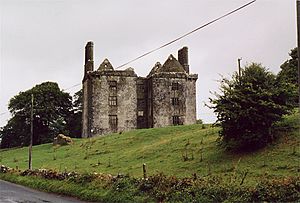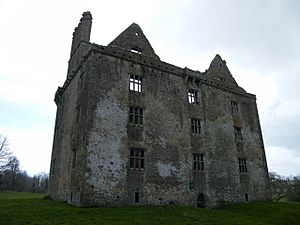Glinsk Castle facts for kids
Quick facts for kids Glinsk Castle |
|
|---|---|
| Native name Irish: Caisleán Ghlinsce |
|
 |
|
| Type | Tower house |
| Location | Glinsk, County Galway, Ireland |
| Built | mid-17th century |
| Official name: Glinsk Castle | |
| Reference no. | 439 |
| Lua error in Module:Location_map at line 420: attempt to index field 'wikibase' (a nil value). | |
Imagine stepping back in time to a grand old building! Glinsk Castle is a special kind of old building called a tower house. It's also a National Monument, which means it's a very important historical site in County Galway, Ireland.
Where is Glinsk Castle?
Glinsk Castle stands right in the middle of Glinsk village. It's found in the beautiful valley of the River Suck. You can find it halfway between the towns of Creggs and Ballymoe.
A Look into Glinsk Castle's Past
Glinsk Castle was built a long time ago, around the mid-1600s. Construction started about 1628. Some people say it was the very last castle ever built in Ireland! Of course, what counts as a "castle" can be tricky. For example, Glenveagh Castle was built much later, in 1870.
This castle was once the main home for the important Burke family of Glinsk. Sadly, the castle was badly damaged by a fire. Even though it burned, much of its structure is still standing today. In 1829, a writer named Skeffington Gibbon visited. He described it as a "terrifying roofless pile" that was full of rats!
Exploring the Castle's Design
Glinsk Castle is built on a strong limestone base. From the castle, you can look out over the countryside. It's said that on a clear day, you can see parts of all five counties in the province of Connacht!
The castle has a rectangular shape. It also has two towers that stick out towards the south. Look up, and you'll see two tall chimney stacks. Each chimney has five diagonal parts that look like a battery of stacks.
The windows of the castle have special stone dividers called mullions. Some windows also have small openings called "weepers" that let water drain away. The castle had many ways to defend itself. These included small openings for guns, called gun loops. It also had small turrets on the corners of the walls, known as bartizans. The lower parts of the castle were very high for protection.
Around the castle, there was once a strong outer wall called a bawn. This wall also had small towers. Today, only a little bit of this bawn wall remains.


